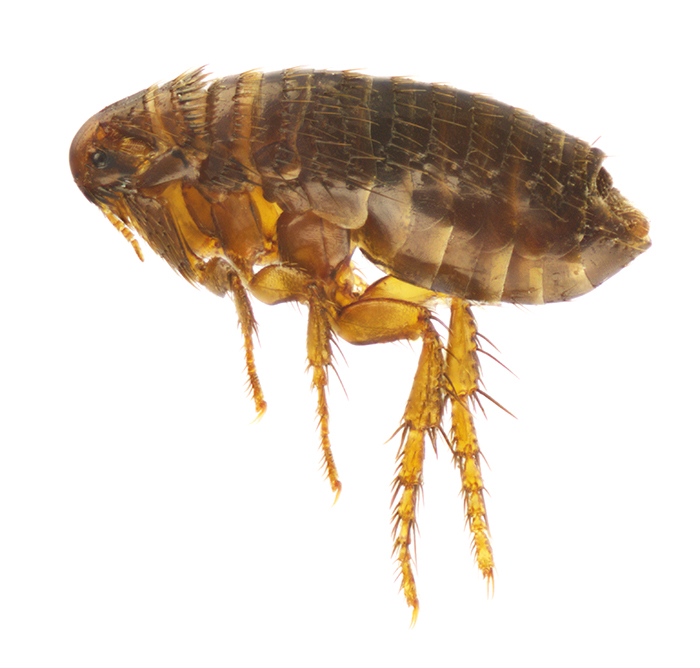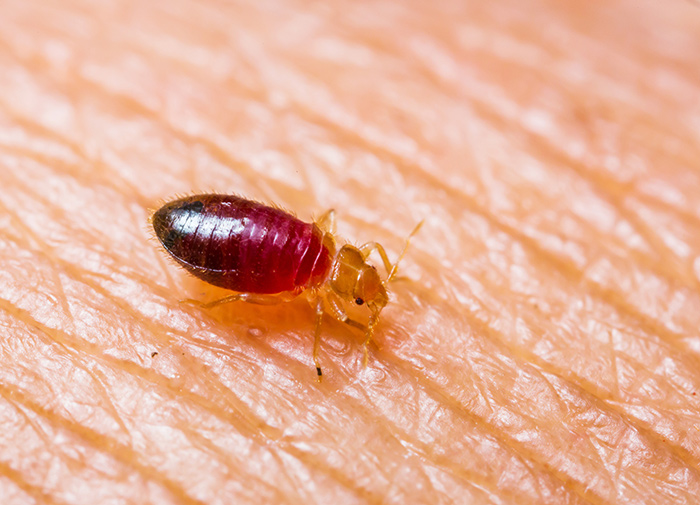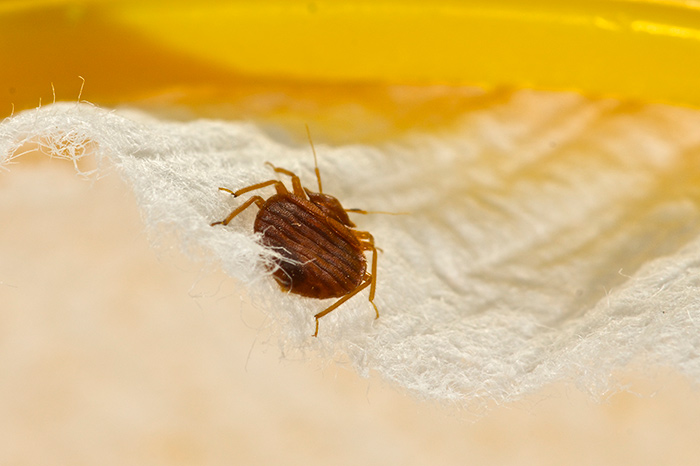Modern life is busy, and financial and family pressures tend to chip away at whatever little free time we have. It’s tough enough to steal a moment for yourself when dealing with life’s ordinary obligations. But throw in a sudden infestation of ants or cockroaches or some such pest, and your stress levels can spike. Just how long will it take to deal with those unwanted creepy crawlies? Will you need to leave your property during a treatment? And how quickly can an application eliminate your pest problem once and for all? Read More about How Long Does Pest Control Take? »
Articles under General
How to Prepare for Pest Control Treatment
Cockroaches and bedbugs. Mosquitoes and mice. Raccoons and rats. Dealing with pests is stressful enough on its own, but preparing for a visit from a pest-control technician? That can add yet another layer of strain. Don’t get too apprehensive about that upcoming visit from a Smithereen technician though. It shouldn’t cause the least bit of concern. Read on to learn all about the basics everyone should follow before pest control treatments take place in your home or business. Read More about How to Prepare for Pest Control Treatment »
Smithereen Pest Management Services Acquires Service Termite & Pest Control
We’re happy to announce that we’ve recently acquired Service Termite & Pest Control, which is based in Danville, Illinois. We’ve already been serving commercial and residential customers across seven states, and we’re excited to extend our reach to Danville, Illinois, Champaign-Urbana, Illinois, and Crawfordsville, Indiana, residents and businesses. Read More about Smithereen Pest Management Services Acquires Service Termite & Pest Control »
What You Should Know About Pest Control for Apartments
Just like single-family homes and businesses, apartments can develop pest problems — and sometimes they can prove challenging. The presence of multiple residents living in close proximity to one another can lead to the unwitting introduction of pests that tenants would prefer to keep far away. Fortunately, Smithereen knows not only how to deal with pest issues, but to do so in a way that minimally impacts tenants’ lives. Read More about What You Should Know About Pest Control for Apartments »
3 Common Household Rodents
Rodent Infestations in residential or commercial settings are typically the result of one of four common mice or rat types. Regardless of the type of rodent, in most cases, once you’ve identified a problem inside or outside your building, its best to get in touch with a pest control expert to eradicate the mice or rat population quickly and effectively. By learning more about these three common rodents you can more easily identify their presence and help control environmental conditions to prevent entry and potential infestation issues. Read More about 3 Common Household Rodents »
What to do after Pest Control Sprays
Jeannette Walls’ The Glass Castle is a memoir about the author’s troubled childhood with a pair of parents more committed to their personal quirks than the well-being of their poverty-stricken children. In one particularly painful scene, a young Jeannette tells her mother about how a friend lives in a home that seems magically free of flies thanks to a No-Pest Strip. But her mother refuses to get one, saying, “If it kills the flies, it can’t be very good for us.” Read More about What to do after Pest Control Sprays »
How Often Should Pest Control be Done?
Regular visits from your neighborhood exterminator include checks for changes or signs of pest activity, checking traps, and putting preventative measures in place to reduce pest populations. With regular visits, even if pests aren’t visible, pest control experts have the chance to inspect the infrastructure of your building or facility and look for new pest-related threats. In addition, regular visits actually help to keep pest management costs down.
Bed Bug Bites vs Flea Bites: How to Tell the Difference

Bed Bug Bites vs Flea Bites: How to Tell the Difference–Bedbug and flea bites are similar at first glance, so telling the difference can be rather difficult. You need to identify the problem so that you can properly treat it, as both insects can carry several diseases that can be passed to humans (and pets).
In general, flea bites can be felt almost immediately, are usually on the lower body, and typically don’t form patterns, appearing as random small groups across different areas. Bug bites won’t be felt until much later, tend to appear on the upper body, and can form patterns of lines or groups. Let’s break down the characteristics of each kind of bite and discuss how to better identify the insects that cause them. Read More about Bed Bug Bites vs Flea Bites: How to Tell the Difference »
#1 Pest Control Companies in Carmel: Kickstart Fighting Bed Bug Infestations Before It Affects your Health!!!
#1 Pest Control Companies in Carmel: Bed Bug Infestations Affecting your Health???You are probably cringing right now, just thinking of bed bugs. These pests are among the most feared by homeowners and, unfortunately, they are on the rise in the US. How can you protect your family from these pests? We will help you understand the health problems that bed bugs cause and develop a plan of action to prevent bed bugs from invading your home.
Pest Control Companies in Carmel: Can Bed Bug Bites Make You Sick?
Bed bugs do not directly make humans sick. In most cases where humans have become ill after bed bug bites, the underlying cause was due to allergies, blood loss, or infection. We’ll discuss that more in a section down below.
But just because bed bug bites don’t directly sicken those who suffer from them doesn’t mean they can’t negatively impact your wellbeing. Medical studies have documented multiple side effects and concomitant ailments that may arise when dealing with bed bugs. In short, getting rid of bed bugs will help you avoid current discomfort and potential future health problems.
Pest Control Companies in Carmel: Do Bed Bugs Spread Disease?
According to a 2012 study published by the American Society for Microbiology, 40 different disease-causing organisms have been detected in bed bugs, but we have no evidence that they transmit these diseases to humans. For most of us, the fact that these diseases have been detected is enough to cause concern. We don’t want these bugs near our families or homes.
Even without disease transmission, bed bugs are known to affect your health in ways that can become serious. Here is just a short list of dangers that bed bugs present:
- Many bites over time can cause significant blood loss and potential anemia
- Allergies to their droppings and remains can cause asthmatic attacks in susceptible people
- Allergies to the bite, caused by bed bug saliva, can trigger hives, rashes, itching and burning
- Bites can become infected, causing additional problems
- Scarring can occur and persist for months or longer
- A few patients develop severe systemic reactions including trouble breathing, severe infections, and anaphylaxis
Pest Control Companies in Carmel: Possible Effects of Bed Bug Bites, Are Bed Bugs Contagious?
 You may not have a reaction the first time you are bitten; however, 70 percent of people will have a reaction. Usually the reaction becomes more severe over time. So, while some people may have no reactions, others will have moderate to severe reactions. The symptoms of a bed bug bite include:
You may not have a reaction the first time you are bitten; however, 70 percent of people will have a reaction. Usually the reaction becomes more severe over time. So, while some people may have no reactions, others will have moderate to severe reactions. The symptoms of a bed bug bite include:
- Red welts on the site of the bite
- Itching or burning at the site
- Bites in a line or grouping
- Widespread rash where bites are numerous
Bed bugs are not “contagious” in the way that diseases are contagious; people sometimes wonder do bed bug bites spread when scratched, and thankfully the answer is no. However, if you visit a home, hotel, or office that is infected, they can hitch a ride home on your clothing or possessions and begin a new infestation at your house. Even the cleanest homes can become infested, so do not hesitate to ask for an inspection and treatment, if you feel you may have bed bugs.
Pest Control Companies in Carmel: How Do I Know If I’ve Been Bitten by a Bed Bug?
If you’ve faced problems with biting insects, you understand that trying to identify the particular bug that’s bothering you can prove challenging. Trying to recognize flea bites vs bed bug bites may seem impossible without prior training, and suffering from spider bites in bed could also be an option, particularly if they’re itchy. And while it’s dangerous to discuss “absolutes” in the world of pest control, when people ask, “Are bed bug bites always itchy?”, we can almost always reply with an affirmative. In general, itchiness and inflammation serve as base-level symptoms that you have bed bugs.
Looking at pictures of bed bug bites also offers another insight, namely that of bite patterns. These insects most typically leave welts in patterns of three that typically cluster in a vague triangle shape or in a straight line. In an ongoing infestation, these bites will multiply over time and often do so in a stop-start pattern. (Bed bugs don’t feed every night.)
The final sign involves what you feel when you initially get bitten: nothing. The CDC states that, “when bed bugs bite, they inject an anesthetic and an anticoagulant that prevents a person from realizing they are being bitten.”
Pest Control Companies in Carmel: Health Problems that Arise from Bed Bugs
 As we stated above, bed bugs don’t directly cause diseases or make you sick. Still, they can cause more than simply itchy bites. While it doesn’t happen often, bed bug bites may lead to allergic reactions in some susceptible individuals. Additionally, repeated scratching sometimes leads to an ordinary secondary infection or (in some cases) cellulitis. Scientific American even reported, “In very severe infestations people can become anemic. That takes a lot of bugs though—maybe 100,000 feeding once a week or more.”
As we stated above, bed bugs don’t directly cause diseases or make you sick. Still, they can cause more than simply itchy bites. While it doesn’t happen often, bed bug bites may lead to allergic reactions in some susceptible individuals. Additionally, repeated scratching sometimes leads to an ordinary secondary infection or (in some cases) cellulitis. Scientific American even reported, “In very severe infestations people can become anemic. That takes a lot of bugs though—maybe 100,000 feeding once a week or more.”
While not quite as frightening as physical effects, bed bug bites often impact sufferers’ mental health. Distracting itching and the anticipation of more bites typically leads to insomnia and increased stress.
Pest Control Companies in Carmel: Treating a Bed Bug Bite on Your Own
Because bed bug bites aren’t normally serious on their own, you can often treat them with over-the-counter remedies. Calamine lotion, hydrocortisone cream, pramoxine ointment, or an antihistamine containing diphenhydramine, cetirizine, loratadine, or fexofenadine can all help. Some even swear by home remedies such as putting lemon juice, baking soda, tea bags, or toothpaste on bed bug bites.
Pest Control Companies in Carmel: Treating a Bed Bug Bite with the Help of a Doctor
Sometimes, though, you should seek the help of a medical professional if you find yourself getting bitten by bed bugs. If you find yourself suffering from a skin infection or having a strong allergic reaction, you should definitely make an appointment with your doctor. Additionally, a physician may be able to prescribe you highly effective treatments such as topical corticosteroids.
Pest Control Companies in Carmel:Protecting Yourself from Bed Bugs
We spend a good amount of time away from home, in offices, our workplace, and other public places. The risk of picking up bed bugs in these spaces is low, but it can happen. It is important to inspect your home when you clean, looking for signs of bed bugs. If you find bed bugs or suspect them, take action quickly to get rid of them. A small infestation can grow to be severe over time.
According to the EPA, there are steps you can take to avoid bringing bed bugs home with you and to prevent an infestation in your home. Consider these tips for preventing bed bugs at your home or workplace.
- Reduce clutter. Clean, clutter-free surfaces give bed bugs nowhere to hide
- Store your personal property in a plastic bin away from the belongings of other people
- Watch for signs of bed bugs in common areas like break rooms, storage areas, upholstered furniture, and other places where people spend time
- Vacuum your area daily to pick up stray bugs and take the vacuum bag all the way to the outside trash area.
Pest Control Companies in Carmel: Getting Rid of Bed Bugs
Do you have a bed bug problem and find yourself wondering how to get rid of bed bugs overnight? Unfortunately, getting rid of bed bugs for good can be difficult. There are three methods that have been shown to be effective: treatment with pesticides, thermal treatment, and freezing bed bugs with cryonite. With any of these three treatments, skill is required to make sure the treatment is thorough and effective.
Many people try to treat their homes themselves and it can be done. If the infestation is small and contained, you may be successful in eliminating the bed bugs. However, many people spend a lot of time and effort in treating their homes, only to have the bed bugs return later. This may be a new infestation, or it may mean that the bugs were not completely eradicated.
Smithereen’s bed bug services are unmatched. We provide an inspection to find the extent of the problem and ensure that all infested surfaces in your house will be treated. We teach you how to recognize the signs of bed bugs, how to prevent re-infestation. Our team is skilled in bed bug eradication and we work to wipe out the entire colony, and ultimately how to prevent bed bug bites. We want you to be successful in eradicating bed bugs from your home permanently.
If you suspect you might have a bed bug problem or if you just want to be sure that you don’t, give us a call at 1-800-336-3500 or contact us. We would be happy to discuss the problem and solutions with you.
#1 Pest Services in Carmel: Tell-Tale Signs that You Have a Bed Bug Infestation
#1 Pest Services in Carmel: Tell-Tale Signs that You Have a Bed Bug Infestation–Just the thought of bed bugs is enough to send most of us into a cringe and unfortunately, they often find their way into the cleanest of homes. Most homeowners don’t even realize they have an infestation until the problem is advanced and they see active bugs, egg sacks, or nymphs. The best way to keep your home bed bug free is to inspect your beds and upholstery regularly and look for tell-tale signs that bed bugs may be nearby.
Pest Services in Carmel:Bed Bug Signs That Are Often Overlooked
 If you’ve read much about bed bugs, you know that one of the questions which comes up repeatedly is, “Are bedbugs actually invisible?” The short answer? No, not at all. Still, it’s easy to understand why people ask. The CDC explains that bed bugs “range from 1mm to 7mm (roughly the size of Lincoln’s head on a penny). …
If you’ve read much about bed bugs, you know that one of the questions which comes up repeatedly is, “Are bedbugs actually invisible?” The short answer? No, not at all. Still, it’s easy to understand why people ask. The CDC explains that bed bugs “range from 1mm to 7mm (roughly the size of Lincoln’s head on a penny). …
They hide during the day in places such as seams of mattresses, box springs, bed frames, headboards, dresser tables, inside cracks or crevices, behind wallpaper, or any other clutter or objects around a bed.”
That’s extremely small, and these itty-bitty insects excel at secreting themselves away in hard-to-access spaces. You may never see a bed bug even if an area in which you live positively teems with them.
Indeed, rarely are such insects so common and so little understood by an average consumer. PestWorld.org, a publication of the National Pest Management Association, notes that approximately 97 percent of pest-control professionals have treated a site for bed bugs within the past year. However, “84 percent of pest control professionals were initially contacted about a different type of pest before identifying them as bed bugs.” Additionally, PestWorld.org noted that roughly 20 percent of all Americans know someone who has dealt with bed bugs or have dealt with them themselves.
Trying to hunt down extremely small and incredibly common bugs with a penchant for hiding sounds like a daunting task. Perhaps, but you generally can spot the signs of bed bugs’ presence. The problem lies with the fact that many people don’t know what to look for. If you think you might have bedbugs, try to discern the following signs.
Pest Services in Carmel:Bed Bug Shells or Molted Skins
A prime indication that you have bed bugs is the presence of bed bug molt. But before you begin your search, you should know how bed bugs develop. Like other insects, bed bugs lack an internal skeleton, relying instead on a stabilizing exoskeleton. As they develop, they go through five different stages, growing from being smaller than a pinhead into insects of about 7mm in size. Each stage requires them to shed that exoskeleton — and that’s what you want to look for.
A bed bug shell should look exactly like a little bed bug. The catch is that there isn’t a tiny animal inside that shell. It has already moved on. You may also find abandoned egg casings. They may appear pale in color and can darken based on the insects’ age.
Where should you look for these casings? Bed bugs tend to live within an eight-foot radius of where people sleep and like to secrete themselves away in and around beds, mattresses, and headboards. They can turn up in the seams of furniture and luggage. During your search, you may also notice a sickly sweet odor reminiscent of raspberries and rot. This is a related sign.
Pest Services in Carmel: Fecal Stains and Blood Stains
Bed bugs are simply gross, and one of the grossest signs of their occupancy involves the remnants and residue of what they eat. Plainly put, bedbugs subsist solely on blood, and you’re likely to find splatters where they feed. When bed bugs bite, they use an anticoagulant to make sure that the blood keeps flowing. That means you and your loved ones may bleed a little more from bites — and leave bloodstains behind on sheets, pillowcases, or pajamas.
Additionally, like all living creatures, bed bugs need to defecate, and you’ll find evidence of their feces around mattresses and on sheets. If it looks like dried blood, it basically is. In fact, if you wet and smudge it, you may notice that it reconstitutes and looks a little like blood.
Pest Services in Carmel: Bite Marks at Night and Early Morning
 Everyone expects to get bitten when bed bugs are around, but their bites differ from those of other insects. You may experience the following systems if you’re dealing with bed bugs:
Everyone expects to get bitten when bed bugs are around, but their bites differ from those of other insects. You may experience the following systems if you’re dealing with bed bugs:
- Bites that cluster in lines around the neck, face, arms, ankles, and other uncovered areas
- Bites that appear late at night or during early in the morning
- Bites that continue to develop into broader welts up to two days after occurring
- A burning feeling on your skin
- Bites that appear on only one side of your body
While no one piece of evidence can tell you that you’re dealing with bed bugs, a pattern of facts that includes most of the bullet points above is pretty definitive.
Pest Services in Carmel:Common Location for Evidence of Bed Bugs
As we’ve already mentioned, bed bugs excel at hiding, and you generally have to work hard to suss them out. Noting that these insects secret themselves away near sleeping areas, the University of Minnesota Extension suggests that you examine the following places:
- boxsprings, mattresses, bed frames, tufts, folds and buttons on mattresses
- furniture such as desks and chairs
- behind wallpaper, clocks and pictures
- cracks in wood floors and under the edge of carpet
The EPA also notes that, in heavily infested areas, you may find bugs in:
- In the seams of chairs and couches, between cushions, in the folds of curtains
- In drawer joints
- In electrical receptacles and appliances
- Under loose wall paper and wall hangings
- At the junction where the wall and the ceiling meet
- Even in the head of a screw
Pest Services in Carmel:How to Get Rid of Bed Bugs
Home-treatment options for bed bugs abound, but few of these work well enough for us to recommend them. Still, you can take steps that will help professionals remove bed bugs from your property.
The first step involves determining that you actually have bed bugs, which we have been covering throughout this article. In addition to following the suggestions detailed above, try to capture a sample of the bugs. This will help a pest-control professional determine if bed bugs are causing your problems.
Next, you should maintain a thorough record of when you find the pests, what signs they leave, and any bites that you experience. This provides additional important information.
Once you’ve determined that you have a bed-bug infestation, you ought to try to contain it as much as possible. This will depend heavily on exactly what items are holding the bed bugs. You may want to throw them out entirely. You may want to seal smaller items in plastic. (The EPA states that letting plastic-sealed items sit for a year guarantees the elimination of bed bugs.)
Finally, contact a qualified pest control provider who can eliminate the bed bugs. Smithereen has more than a century of experience in dealing with all sorts of irritants, including insects, wildlife, rodents, and bed bugs. Our integrated pest management practices are tough on pests, but won’t harm you, your home, or the environment. We can:
- Perform a thorough inspection
- Help you understand bed bugs and how to get rid of them
- Teach you how to avoid re-infestation
- Show you the best strategies to deal with your bed bug problem
The first step in getting rid of your bed bugs is to give us a call at (800) 336-3500. We can handle the rest!
![]()
